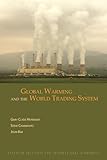Global warming and the world trading system / Gary Clyde Hufbauer, Steve Charnovitz, Jisun Kim.
Material type: TextPublication details: Washington, D.C. : Peterson Institute for International Economics, c2009.Description: xiii, 166 p. ; 23 cmISBN:
TextPublication details: Washington, D.C. : Peterson Institute for International Economics, c2009.Description: xiii, 166 p. ; 23 cmISBN: - 9780881324280 (paperback)
- 0881324280 (paperback)
- 9781441608864 (e-book)
- 1441608869 (e-book)
- 363.738
- HF 1379 H889g 2009
| Item type | Current library | Home library | Collection | Shelving location | Call number | Vol info | Copy number | Status | Date due | Barcode |
|---|---|---|---|---|---|---|---|---|---|---|
 Libro
Libro
|
Biblioteca Juan Bosch | Biblioteca Juan Bosch | Ciencias Sociales | Ciencias Sociales (3er. Piso) | HF 1379 H889g 2009 (Browse shelf(Opens below)) | 1 | 1 | Available | 00000094559 |
Includes bibliographical references (p. 147-153) and index.
Introduction -- Overview of applicable World Trade Organization rules -- Status of climate measures under the law of the World Trade Organization -- Future climate policy and the World Trade Organization -- Elements of a trade and climate code.
In 2006, a team led by the English economist Sir Nicholas Stern issued a striking report that analyzed the economic dimensions of global climate change and called for immediate collective action to reduce greenhouse gas (GHG) emissions. This seminal report poses the critical question of how much emissions should be reduced within specific timeframes. To answer the challenge of finding a best-practices approach, Global Warming and the World Trading System looks at the economic aspects of GHG emissions and seeks a policy method to reduce them without adversely affecting global trade. The book begins with a survey of relevant data--such as emissions reports per sector--and evaluates current US climate policy options, focusing on the intricacies of specific Congressional bills. In this vein, this study examines whether the competitiveness provisions now under consideration are compatible with the rules of the World Trade Organization (WTO) and explores the pragmatic opportunities the WTO should capitalize on in order to accomplish two goals simultaneously: (1) Ensure policy space for countries to limit national GHG emissions without sacrificing the competitive position of their own industries. (2) Preserve an open trading system relatively free of discrimination and opportunistic protectionist measures. Should governments use trade measures to encourage other countries to cooperate in the adoption of environmental policies? The authors anticipate the potential negative environmental and economic outcomes as well as the disputes over violation of GATT articles. This book addresses how to avoid serious setbacks in an effort to reduce emissions without compromising the status of both domestic and international carbon-intensive industries. Most importantly, the book considers what can be done by environmental organizations to head off conflict with the WTO -- Product Description.


There are no comments on this title.